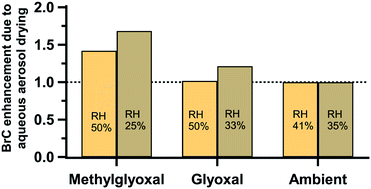当前位置:
X-MOL 学术
›
Environ. Sci.: Processes Impacts
›
论文详情
Our official English website, www.x-mol.net, welcomes your
feedback! (Note: you will need to create a separate account there.)
No evidence for brown carbon formation in ambient particles undergoing atmospherically relevant drying.
Environmental Science: Processes & Impacts ( IF 4.3 ) Pub Date : 2020-02-03 , DOI: 10.1039/c9em00457b Vikram Pratap 1 , Michael A Battaglia 1 , Annmarie G Carlton 2 , Christopher J Hennigan 1
Environmental Science: Processes & Impacts ( IF 4.3 ) Pub Date : 2020-02-03 , DOI: 10.1039/c9em00457b Vikram Pratap 1 , Michael A Battaglia 1 , Annmarie G Carlton 2 , Christopher J Hennigan 1
Affiliation

|
Recent laboratory studies have reported the formation of light-absorbing organic carbon compounds (brown carbon, BrC) in particles undergoing drying. Atmospheric particles undergo cycles of humidification and drying during vertical transport and through daily variations in temperature and humidity, which implies particle drying could potentially be an important source of BrC globally. In this work, we investigated BrC formation in ambient particles undergoing drying at a site in the eastern United States during summer. Aerosol BrC concentrations were linked to secondary organic aerosol (SOA) formation, consistent with seasonal expectations for this region. Measurements of water-soluble organic aerosol concentrations and light absorption (365 nm) were alternated between an unperturbed channel and a channel that dried particles to 41% or 35% relative humidity (RH), depending on the system configuration. The RH maintained in the dry channels was below most ambient RH levels observed throughout the study. We did not observe BrC formation in particles that were dried to either RH level. The results were consistent across two summers, spanning ∼5 weeks of measurements that included a wide range of RH conditions and organic and inorganic aerosol loadings. This work suggests that mechanisms aside from humidification-drying cycles are more important contributors to ambient particle BrC loadings. The implications of this work on the atmospheric budget of BrC are discussed.
中文翻译:

没有证据表明经过大气相关干燥的环境颗粒中会形成棕色碳。
最近的实验室研究报告了在干燥的颗粒中会形成吸光性有机碳化合物(棕碳,BrC)。大气颗粒在垂直运输过程中以及每天温度和湿度的变化中都会经历加湿和干燥的循环,这意味着颗粒干燥可能成为全球BrC的重要来源。在这项工作中,我们调查了夏季在美国东部某地点进行干燥的环境颗粒中BrC的形成。气溶胶BrC的浓度与次生有机气溶胶(SOA)的形成有关,与该地区的季节性预期一致。在不受干扰的通道和将颗粒干燥至相对湿度(RH)41%或35%的通道之间交替进行水溶性有机气溶胶浓度和光吸收(365 nm)的测量,具体取决于系统配置。在整个研究过程中,在干燥通道中维持的相对湿度低于大多数周围相对湿度水平。我们没有观察到在干燥至任一RH水平的颗粒中均形成BrC。在两个夏季的测量结果中,结果一致,跨越了大约5周的时间,其中包括各种相对湿度条件以及有机和无机气溶胶含量。这项工作表明,除加湿-干燥循环外的其他机制对周围颗粒BrC的负载更重要。讨论了这项工作对BrC大气预算的影响。取决于系统配置。在整个研究过程中,在干燥通道中维持的相对湿度低于大多数环境相对湿度水平。我们没有观察到在干燥至任一RH水平的颗粒中均形成BrC。在两个夏季的测量结果中,结果一致,跨越了大约5周的时间,其中包括各种相对湿度条件以及有机和无机气溶胶含量。这项工作表明,除加湿-干燥循环外的其他机制对周围颗粒BrC的负载更重要。讨论了这项工作对BrC大气预算的影响。取决于系统配置。在整个研究过程中,在干燥通道中维持的相对湿度低于大多数周围相对湿度水平。我们没有观察到在干燥至任一RH水平的颗粒中均形成BrC。在两个夏季的测量结果中,结果一致,跨越了大约5周的时间,其中包括各种相对湿度条件以及有机和无机气溶胶含量。这项工作表明,除加湿-干燥循环外的其他机制对周围颗粒BrC的负载更重要。讨论了这项工作对BrC大气预算的影响。在两个夏季的测量结果中,结果一致,跨越了大约5周的时间,其中包括各种相对湿度条件以及有机和无机气溶胶含量。这项工作表明,除加湿-干燥循环外的其他机制对周围颗粒BrC的负载更重要。讨论了这项工作对BrC大气预算的影响。在两个夏季的测量结果中,结果一致,跨越了大约5周的时间,其中包括各种相对湿度条件以及有机和无机气溶胶含量。这项工作表明,除加湿-干燥循环外的其他机制对周围颗粒BrC的负载更重要。讨论了这项工作对BrC大气预算的影响。
更新日期:2020-02-26
中文翻译:

没有证据表明经过大气相关干燥的环境颗粒中会形成棕色碳。
最近的实验室研究报告了在干燥的颗粒中会形成吸光性有机碳化合物(棕碳,BrC)。大气颗粒在垂直运输过程中以及每天温度和湿度的变化中都会经历加湿和干燥的循环,这意味着颗粒干燥可能成为全球BrC的重要来源。在这项工作中,我们调查了夏季在美国东部某地点进行干燥的环境颗粒中BrC的形成。气溶胶BrC的浓度与次生有机气溶胶(SOA)的形成有关,与该地区的季节性预期一致。在不受干扰的通道和将颗粒干燥至相对湿度(RH)41%或35%的通道之间交替进行水溶性有机气溶胶浓度和光吸收(365 nm)的测量,具体取决于系统配置。在整个研究过程中,在干燥通道中维持的相对湿度低于大多数周围相对湿度水平。我们没有观察到在干燥至任一RH水平的颗粒中均形成BrC。在两个夏季的测量结果中,结果一致,跨越了大约5周的时间,其中包括各种相对湿度条件以及有机和无机气溶胶含量。这项工作表明,除加湿-干燥循环外的其他机制对周围颗粒BrC的负载更重要。讨论了这项工作对BrC大气预算的影响。取决于系统配置。在整个研究过程中,在干燥通道中维持的相对湿度低于大多数环境相对湿度水平。我们没有观察到在干燥至任一RH水平的颗粒中均形成BrC。在两个夏季的测量结果中,结果一致,跨越了大约5周的时间,其中包括各种相对湿度条件以及有机和无机气溶胶含量。这项工作表明,除加湿-干燥循环外的其他机制对周围颗粒BrC的负载更重要。讨论了这项工作对BrC大气预算的影响。取决于系统配置。在整个研究过程中,在干燥通道中维持的相对湿度低于大多数周围相对湿度水平。我们没有观察到在干燥至任一RH水平的颗粒中均形成BrC。在两个夏季的测量结果中,结果一致,跨越了大约5周的时间,其中包括各种相对湿度条件以及有机和无机气溶胶含量。这项工作表明,除加湿-干燥循环外的其他机制对周围颗粒BrC的负载更重要。讨论了这项工作对BrC大气预算的影响。在两个夏季的测量结果中,结果一致,跨越了大约5周的时间,其中包括各种相对湿度条件以及有机和无机气溶胶含量。这项工作表明,除加湿-干燥循环外的其他机制对周围颗粒BrC的负载更重要。讨论了这项工作对BrC大气预算的影响。在两个夏季的测量结果中,结果一致,跨越了大约5周的时间,其中包括各种相对湿度条件以及有机和无机气溶胶含量。这项工作表明,除加湿-干燥循环外的其他机制对周围颗粒BrC的负载更重要。讨论了这项工作对BrC大气预算的影响。











































 京公网安备 11010802027423号
京公网安备 11010802027423号